Abstract
Urban rail transit stations serve as pivotal hubs that facilitate the advancement of diverse economic activities. Based on different types of metro stations, the sustainable and coordinated development of public transport and land use can be achieved through rational land use planning and the rational allocation of urban infrastructure and public service facilities. Drawing upon mobile phone signaling data and land use data, this article presents a complex classification methodology for metro stations, employing the lens of “passenger flow behavior—land use structure—job-housing density” in the context of Xi’an. The stations are categorized into six distinct types, including employment-led stations with a job–housing density balance, as well as stations characterized by job–housing mismatch with a high residential density. The results indicate a low level of coupling between the passenger flow patterns of the stations and the spatial characteristics of the station areas. In addition, the spatial distributions of the stations demonstrate a significant aggregation effect in each station type, while the degree of integration between the different station types remains limited. These findings collectively suggest that the urban rail transit stations in Xi’an have not achieved complementary development, thereby reflecting a notable trend of cross-regional commuter flow in the city.
1. Introduction
Urban rail transit has emerged as a pivotal component of transportation infrastructure in numerous cities, serving as a catalyst for promoting environmentally friendly, low-carbon, and sustainable modes of travel. Moreover, the stations associated with these transit systems assume critical roles as vital hubs, facilitating a myriad of social and economic activities in urban settings. It is worth noting that the diverse array of station types exhibits distinct characteristics pertaining to their geographical placements, functional orientations, land utilizations, and pedestrian flow dynamics. As of the conclusion of the year 2020, a staggering 538 cities spanning 77 countries and regions across the globe have successfully implemented urban rail transit systems, including an impressive operational mileage of 33,346.37 km and an excess of 34,220 stations [1].
Urban rail transit and CACC of autonomous vehicles [2,3] are both considered ways to reduce carbon emissions. In recent years, there has been an accelerated pace in the construction of urban rail transit projects and the implementation of metro planning in major cities. However, this development has also given rise to a range of issues in station areas, such as the segregation of work and residential commuting along the corridor [4] and the high peak passenger flow sharing rate [5]. These problems are fundamentally caused by the mismatch between the travel patterns of weekday metro users and the spatial characteristics of the station areas [6]. They reflect the complex relationship between “passenger flow—job-housing—and land use”, resulting in spatial and temporal variations in station types [7]. The pattern of passenger flow exhibits spatial heterogeneity across different types of metro stations due to the influence of factors in the built environment [8]. By categorizing urban rail stations, it is possible to explain the heterogeneity among different station types in terms of the surrounding land structure, passenger flow characteristics, and crowd attributes [9]. This classification enables a comprehensive understanding of the interdependent relationship between station commuting patterns and the spatial characteristics of the station areas [10]. Hence, the classification of stations holds significant relevance for urban planning and urban design, particularly in terms of station area density, land use, and development opportunities. This classification study assumes paramount importance in the construction of urban rail transit, as it serves as a key element in the rational planning of station areas and the effective guidance of station area activities. Therefore, it contributes to the overall sustainable development of the city [8]. In addition, station classification provides a foundation for analyzing the interchange and connection modes among different stations, as well as for optimizing the control of the surrounding land, design schemes, and facility configurations of rail transit stations [11]. Therefore, it is necessary to avoid generalizing urban rail transit stations, as their scientific classification forms the basis for TOD [12] and the optimization of rail transit infrastructure. Thus, during this period of rapid development in urban rail transit construction, traffic stations assume crucial roles as vital nodes connecting the surrounding urban space. Their classification facilitates the study of variations in land use, passenger flow patterns, the optimization of urban spatial layout, and the prediction of passenger flow for new line stations, among other essential aspects [13].
The study of the classification of urban rail transit stations has garnered significant attention in recent times. This attention has been driven by policymakers and urban planners worldwide. For instance, China’s Guidelines for Facilities Space Planning and Design Around Urban Rail Transit Stations have played a crucial role in this regard. These guidelines consider three dimensions, namely the station location, transportation function, and surrounding land use, to classify urban rail transit stations into 24 categories. The Guidelines for Planning and Design of Areas Along Urban Railways also contribute to the classification of urban railway stations. They categorize stations into six types, including hub stations, central stations, cluster stations, and general stations. This classification is based on the attributes of station connection relationships and the number of lines associated with each station [14]. Ren [15] drew inspiration from the “Nodes and Places” model [16,17], and classified Singapore’s rail station areas into city center stations, regional center stations, town center stations, and neighborhood center stations. These classifications are based on the synergy between the rail station areas and various levels of centers. In Japan, cities such as Tokyo and Tsukuba classify subway stations into three classes based on their location, traffic intensity, and interchange coefficient [18].
The kernel issue of site classification research lies in the utilization of a clustering algorithm and the selection of indicators. Presently, the K-means algorithm stands as the predominant choice for site classification clustering, representing one of the most extensively employed algorithms in cluster analysis [19,20,21,22]. This algorithm partitions n objects into k clusters based on their attributes with the aim of ensuring that the resulting clusters adhere to the following criteria: objects in the same cluster exhibit a greater degree of similarity, while objects belonging to distinct clusters display reduced similarities. Under this algorithmic framework, the value of k necessitates a predetermined assignment; however, in practical application, estimating the appropriate value for k proves to be a formidable task. Additionally, certain scholars have explored alternative classification methodologies. For instance, Meekyung [23] employed a GMM model in conjunction with subway swipe card data, employing a hybrid clustering algorithm for unsupervised learning to classify subway stations in Seoul. Ma [24], on the other hand, employed remotely sensed land use data and employed a hierarchical analysis approach to identify the type of TOD development in station areas. Yang [25] and Chen [26] both utilized subway swipe card data to identify the type of TOD development in station areas, employing the random forest machine learning method to analyze the spatial distribution characteristics of rail transit station types in Wuhan and Shanghai, respectively.
The extant methodologies used to classify urban rail transit stations include various classification indices, including passenger flow indices, land structure indices, and comprehensive indices. ① Passenger flow indices primarily focus on the inbound and outbound passenger flow characteristics of urban rail transit stations. Typically, time series skewness, time series kurtosis, and the peak hour coefficient are employed to signify the passenger flow characteristics of the station. For instance, Roth [27] obtained subway passenger movement characteristics and classified the spatio-temporal patterns of passenger travel based on the London Oyster big data. Yin [19] introduced a time series clustering method to classify Beijing subway stations based on passenger flow characteristics. Tan [20] utilized the principal component analysis method to extract features from Guangzhou subway station passenger flow data for station identification. ② The methodologies employed for the classification of urban rail transit stations that utilize land use structure indicators typically comprise the utilization of indicators such as land use mix [28] and land use dominance to portray the land use structure surrounding the station. For instance, Duan [10] employed a combination of qualitative and quantitative methods to classify station types based on the functional characteristics of the land in the station influence area. ③ In addition, the approach of classifying urban rail transit stations through the utilization of a combination of indicators takes into consideration both the passenger flow characteristics of the station and the built environment surrounding it. For instance, Liao [29] integrated demand and morphology indicators to classify Beijing metro stations. Jiang [30] further refined the classification of rail transit stations by considering the inbound passenger flow data of the stations and the surrounding land use characteristics, while also taking into account the segmentation characteristics of different stations belonging to the same broad category of stations. Additionally, Zhou [31] devised a method for classifying stations by employing a reduced-dimensional K-means clustering algorithm that incorporates the dual perspective of the station network structure and passenger flow information.
In the field of urban rail transit station classification research, two significant research gaps necessitate attention. Firstly, the acquisition of urban rail transit station passenger flow data represents a crucial attribute for capturing station characteristics. However, the current approach to obtaining such data remains relatively limited, predominantly relying on the extraction of inbound and outbound passenger flow through Automatic Fare Collection swipe card data. The advantage of Automatic Fare Collection data lies in its direct provision of card data pertaining to the ingress and egress of urban rail transit stations, thereby ensuring a high degree of accuracy in the extracted inbound and outbound passenger flows. Nevertheless, this data source fails to include passenger attributes, travel chains, and other pertinent information, thereby exhibiting a relatively narrow data type. Conversely, mobile phone signaling data offer a more comprehensive data set, including precise information such as user ID, travel tracking, and travel start and end times, which are automatically recorded. If mobile phone signaling data can be harnessed to more accurately extract passenger flow entering and exiting urban rail transit stations, this would not only expand the avenues for acquiring such data but also facilitate subsequent research on the relationship between urban rail transit passengers and the spatial domains of stations. Secondly, the existing classification methods partially capture certain characteristics of urban rail transit stations. However, the selection of categorization indicators in relevant studies predominantly revolves around “passenger flow” and “land use”, neglecting an analysis of the interrelationship between the commuting patterns of station passenger flow and the surrounding occupational and residential populations.
This paper attempts to address the aforementioned research gaps through analyzing the case of Xi’an. Utilizing mobile phone signaling data, the researchers procured information pertaining to the inbound and outbound passenger flows of 66 metro stations including lines 1–4 in the third ring road of Xi’an, as well as the occupational and residential population densities surrounding the study stations. Additionally, land use data were employed to acquire knowledge regarding the land use types surrounding the study stations. By means of hierarchical clustering and the K-means clustering method, this study successfully identified the various types of metro stations in Xi’an. The stations were categorized into six distinct types and their spatial distribution characteristics were explored. The urban rail transit stations in Xi’an do not form clusters that foster complementary development. In addition, an analysis of the distribution of metro station types was conducted in conjunction with the spatial distribution characteristics of employment in Xi’an. Finally, this study proposed a spatial balancing strategy for the station area, which was predicated upon the interaction relationship between the commuting characteristics of the passenger flow and the employed and residential populations residing in the vicinity of the station, objectively ameliorating the issue of mismatched commuting.
2. Research Design
2.1. City Context
Xi’an, one of China’s megacities and the capital of Shaanxi Province, features a comprehensive urban infrastructure. As of the end of 2022, the city comprises 11 districts and two counties, spanning a vast area of 10,108 km2. The resident population stands at an impressive 12,995,900 people, with an urbanization rate of 79.59% [32]. Notably, Xi’an has successfully established a sophisticated metro system, comprising nine lines that span a total length of 301 km. This complex network includes 187 operational stations [33] (Figure 1). In the year of 2023, the Xi’an Metro anticipates accommodating an average daily passenger volume of 3,863,500 passengers/d, with a passenger intensity of 1.5 million passengers/(km-d) [34]. By 2025, the Xi’an metropolitan area aims to construct a comprehensive rail transit network, including 12 lines and spanning a total length of 422 km, which is expected to support the objective of a 1 h commuting time within the Xi’an metropolitan area [35].

Figure 1.
Research scope map.
The rapid expansion of the Xi’an metro system has brought to the forefront the issue of a high passenger flow and the separation of work and residential areas along the corridors within the city’s third ring road. Notably, the network of metro lines 1–4 bears the brunt of this passenger traffic (Figure 2). Among these lines, Xi’an metro line 2 has garnered significant attention. According to data from the China Urban Rail Transit Association, in 2020, it ranked fourth nationwide in terms of average daily passenger traffic intensity, with a staggering 25,100 passengers/(km-d). Therefore, this article focuses on the analysis of 66 metro stations located within the third ring road of Xi’an, specifically lines 1–4. The objective is to assess the relationship between the station traffic commuting patterns and the spatial characteristics of the station areas, considering the overlapping factors of “passenger flow—land use—employment and residence”. In addition, this study aims to explore the fine classification of urban rail transit stations during weekdays.

Figure 2.
Average daily passenger flow of metro lines in Xi’an.
2.2. Data Processing
2.2.1. Mobile Phone Signaling Data
This research utilizes mobile phone signaling data obtained from China Unicom during the month of October in the year 2019 (Appendix A).
- (1)
- The identification and processing of passenger flow in and out of urban rail transit stations
Specifically, the steps of extracting the data on the passenger flow in and out of stations based on mobile phone signaling data are as follows:
Step 1: With reference to the density of communication base stations in the research area, the spatial extent is divided into spatial cells measuring 250 m × 250 m, denoted as ‘n’. The well-known text (WKT) representation of these cells is exported to the JI Smart platform.
Step 2: In the JI Smart platform, the count of journeys originating from each spatial unit at the starting point (start poi) [36] of each user’s journey, whose mode of transport is urban rail, is extracted for each weekday between 6:00 and 7:00 over the course of a month.
Step 3: Similarly, in the JI Smart platform, the count of journeys terminating at each spatial unit at the ending point (end poi) of each user’s journey, whose mode of transport is urban rail, is extracted for each weekday between 6:00 and 7:00 over the course of a month.
Step 4: By aggregating the counts of starting points for each spatial unit (On1, On2……Onm) in proximity to the nearest urban rail transit station, the total number of individuals entering station A on a daily basis between 6:00 and 7:00 can be obtained (AOn1 + AOn2 +…+ AOnm). Likewise, by aggregating the counts of ending points for each spatial unit (Dn1, Dn2……Dnm) in proximity to the nearest urban rail transit station, the total number of individuals exiting station A on a daily basis between 6:00 and 7:00 can be obtained (Figure 3).
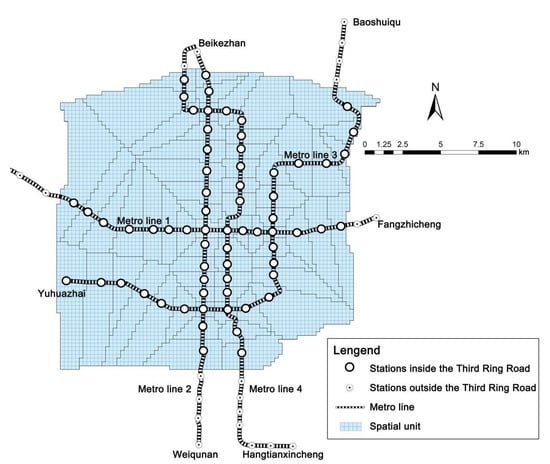
Figure 3.
Metro stations associated with each spatial unit in Xi’an.
Step 5: Repeat steps 2–4 to extract the passenger flow from 6:00 to 24:00 on each working day in a month and finally derive the average value.
To fully explain the characteristics of the data, the statistical data pertaining to the ingress and egress of passengers at urban rail transit stations were processed into a comprehensive data set (Table 1) in the confines of this paper. Each individual entry in the aforementioned data set represents the passenger flow at a given station from 6:00 to 24:00, with the passenger flow value denoting the average passenger influx throughout all weekdays. Building upon this foundation, it is necessary to subject the passenger flow to further standardization procedures.

Table 1.
Hourly inbound passenger flow at selected study stations.
- (2)
- The identification and processing of employed and resident populations
The determination of the employed and resident populations is predicated upon the stay status of the individuals under consideration.
Step 1: When an individual consistently remains at a particular location between the hours of 20:00 and 5:00 for a duration of 10 days in a given month (not continuously), the location is determined to be the user’s residence point.
Step 2: When an individual spends a minimum of 7 h at a specific location between the hours of 8:00 and 20:00 for a duration of 10 days in a given month (not continuously), the location is determined to be the user’s workplace point.
Step 3: Excluding the behaviors of students going to and from school, the identification of the above identified commuter population is restricted by age.
Step 4: The starting point and arrival point are limited, that is, the user’s trip starts from the residence point and ends at the work point or starts from the work point and ends at the residence point. (Figure 4).
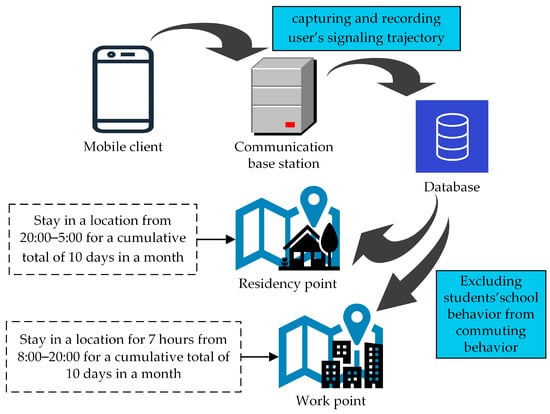
Figure 4.
Method flow chart of occupational and residential population identification based on mobile phone signaling data.
2.2.2. Land Use Data
In this paper, the land use within a radius of 800 m [37,38] from 66 metro stations is mapped utilizing high-resolution remote sensing images obtained from Google Earth and supplemented by field surveys conducted in 2019. Subsequently, the land use structure information is subjected to analysis employing the ArcGIS 10.8 software (Figure 5).
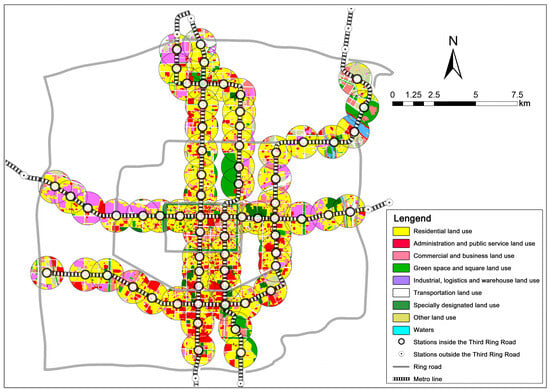
Figure 5.
Land use map of 800 m around the study stations.
2.3. Methodology
Within the scope of this study, a novel approach is introduced to analyze the temporal patterns of the passenger flow characteristics. The time series data are subjected to a comprehensive feature extraction process from diverse perspectives. Therefore, the time series clustering analysis is reformulated to describe the time series data in terms of these newly derived features. Additionally, the land use structure and the employed and resident populations in the vicinity of the stations are incorporated to depict the notable attributes of each station. Among various clustering algorithms, the K-means clustering method is selected due to its simplicity, comprehensibility, computational efficiency, and compatibility with continuous data. Considering that the data employed in this clustering analysis predominantly consist of continuous variables, the K-means clustering algorithm is deemed appropriate. As mentioned earlier, the determination of the optimal value for the parameter k is necessary prior to executing the K-means clustering algorithm. Therefore, this study initially employs the hierarchical clustering method to determine the appropriate number of clusters for the 66 sites. Subsequently, the final clustering results are obtained through the utilization of the K-means clustering method.
2.3.1. Hierarchical Clustering Method
In the hierarchical clustering method, the initial determination of distance and the subsequent calculation of inter-class distances are undertaken. Subsequently, the data points that exhibit closer proximity are progressively merged into a unified class based on their respective distances. This process continues iteratively until all data points are consolidated into a single class. The comprehensive analysis procedure can be represented through the utilization of a tree diagram.
2.3.2. K-Means Clustering Algorithm
Mean clustering, also referred to as rapid clustering, represents a classical approach in data mining. Generally, the determination of the number of categories, denoted as K, precedes the analysis. The entire analytical process employs an iterative methodology, commencing with an initial classification. Subsequently, the data points are transferred between different categories through continuous iterations until a specific criterion is finally satisfied [39,40].
2.3.3. Measurements of Passenger Flow Time Series and Intensity Characteristics
Time series possess multiple attributes, each of which provides insight into various aspects of the temporal progression. In this study, morphological and structural features are extracted to quantify the passenger flow–time series curve. Specifically, the extreme value point, skewness, and kurtosis of the time series serve as parameters for measurement [41]. Considering that the temporal characteristics alone fail to capture the magnitude of passenger flow, the peak hour coefficient and equilibrium coefficient of the passenger flow time distribution are introduced to analyze the intensity of the passenger flow [42].
- (1)
- Passenger flow time series characteristics
The extremum point (C1) represents the coordinates, both horizontally and vertically, that correspond to the maximum or minimum value of the function image in a specific subinterval. By utilizing mobile phone signaling data, it becomes possible to acquire the hourly distribution of passenger traffic at each station, which exhibits varying numbers of peaks across different stations. Therefore, the maximum count is selected as the characteristic value for the time series.
Skewness (C2) is a statistical measure that describes the pattern of the data distribution, specifically addressing the symmetry of the overall value distribution. This statistical measure necessitates a comparison with the normal distribution. A skewness value of 0 indicates that the data distribution pattern possesses the same degree of skewness as the normal distribution. Conversely, a positive skewness value indicates a right-skewed distribution, while a negative skewness value indicates a left-skewed distribution.
Kurtosis (C3) is a statistical measure that characterizes the steepness of the data distribution pattern. A kurtosis value of 0 signifies that the data distribution possesses a steepness equivalent to that of the normal distribution. Conversely, a positive kurtosis value indicates a steeper data distribution, whereas a negative kurtosis value indicates a smoother distribution [43].
- (2)
- Passenger flow intensity characteristics
The time period (hourly) coefficient of the passenger flow, p, represents the share of passenger flow in a given hour of the day as a proportion of the whole day’s passenger flow. The formula is as follows:
where is the passenger flow (in units of passengers) at hour and is the passenger flow throughout the day. The maximum of p is the peak hour factor (C4).
The passenger flow time distribution equalization factor (C5) is calculated as follows:
where is the average peak hour passenger flow and is the average flat hour passenger flow.
2.3.4. Measurements of Land Use Structure Characteristics
The urban rail network traverses diverse regions in the city, and the land utilization patterns surrounding each station exhibit significant variations, thereby contributing to distinct interactions with passenger activities. The land utilization structure indicator possesses the capacity to explain the characteristics of land distribution surrounding the station, thereby effectively reflecting the principal functions of said station. By integrating the station area land structure calculation method proposed by Duan [10], the parameters for clustering the land structure features include the degree of land utilization mixture, the degree of land utilization dominance, and the index of land utilization uniformity within an 800 m radius of the station’s vicinity (Table 2). The calculation formula is presented as follows:
where is the land use mixture degree; is the land use dominance degree; is the land use uniformity index; is the proportion of area occupied by land use type ; and is the total number of land use types in the region.

Table 2.
Evaluation of land use indicators around selected study stations.
2.3.5. Measurements of Job–Housing Population Characteristics
Drawing upon the employment and residential locations identified through mobile phone signaling data, ArcGIS 10.8 is employed to enumerate the employed population density (P1) and resident individuals (P2) residing in the proximity of the station.
In this study, the eigenvalues of 66 metro stations in Xi’an were individually extracted, yielding a total of 15 eigenvalues (Table 3). Subsequently, the stations characterized by these eigenvalues were subjected to hierarchical clustering and K-means clustering analyses. For hierarchical clustering, the intergroup linkage method was selected in SPSS version 26, employing the squared Euclidean distance as the metric and utilizing the 15 eigenvalues as variables. For K-means clustering, the 15 eigenvalues were employed as the variables, and the ANOVA table and clustering information for each case served as the statistical measures.

Table 3.
Eigenvalues of selected study stations.
3. Results
3.1. Determination of the Number of Clusters
The dendrogram derived from hierarchical clustering facilitates the determination of the optimal number of classes to classify the metro stations in Xi’an. The number of hierarchical clusters at different distances (Figure 6) reveals that the turning points occur at 16, 10, and 7 clusters. Therefore, the subsequent step of K-means clustering sets the number of clusters for the 66 stations in Xi’an as 7.
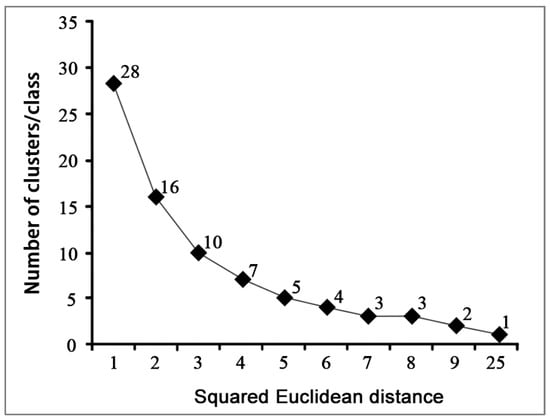
Figure 6.
Variation in the number of hierarchical clusters under squared Euclidean distance.
3.2. K-Means Clustering Results
Premised on the K-means clustering analysis, the 66 metro stations located within the third ring road of Xi’an, belonging to metro lines 1 to 4, were categorized into seven distinct clusters, namely Cluster 1 to Cluster 7. According to Table 4, it is evident that Cluster “2” and Cluster “3” exhibit similar characteristics, leading to the consolidation of the seven original categories into six. To interpret the relationship between the passenger flow at each station and the employed and resident populations residing in the vicinity, the six station categories were further summarized utilizing the C + P model (C represents the characteristics of the station’s passenger flow, while P signifies the characteristics of the employed and resident populations surrounding the station).

Table 4.
Clustering results for each type of station with typical parameter averages.
The resulting categorizations are as follows: employment-led stations with a job–housing density balance (Cluster 1), job–housing mismatch stations with a high residential density (Cluster 2 and Cluster 3), mismatch-biased employment stations with a job–housing density balance (Cluster 4), mismatch-biased employment stations with a high residential density (Cluster 5), mismatch-biased residence stations with a high residential density (Cluster 6), and comprehensive stations with a job–housing density balance (Cluster 7) (Table 5). To illustrate, let us consider employment-led stations with a balanced job–housing density. In this case, the population density of both employment and residence in the vicinity of this type of station is approximately equal, yet the passenger flow characteristic of this particular station type is predominantly influenced by employment. The classification results effectively demonstrate that the passenger flow characteristics of Xi’an metro stations exhibit a relatively weak correlation with the spatial attributes of the station’s surroundings.

Table 5.
Classification results of research stations.
- (1)
- Employment-led stations with job–housing density balance
As evidenced by the temporal distribution curve of the passenger flow, the station under consideration exhibits a pattern characterized by a significant influx of outbound passengers during the morning peak hours and inbound passengers during the evening peak hours. Conversely, the flow of passengers during other time intervals is comparatively smaller, thus classifying it as a single-peak type. However, when examining the land utilization characteristics and the demographic composition of the employed and resident populations in the vicinity of these stations, it becomes apparent that the land use mix is of moderate nature, and the equilibrium between the employed and resident populations is essentially maintained. Therefore, this particular type of station can be categorized as an employment-led station with a job–housing density balance (Figure 7). Typical examples of such stations include Beidajie, Kejilu, and Tiyuchang.
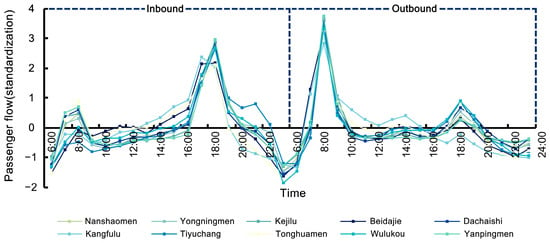
Figure 7.
Hourly distribution of passenger flow in and out of employment-led stations with job–housing density balance.
- (2)
- Job–housing mismatch stations with high residential density
The time series distribution curve of the passenger flow for this specific type of station exhibits a bimodal pattern (Figure 8), accompanied by a significant peak hour factor and a passenger flow time distribution equalization factor. Despite the complex and diverse land composition surrounding this type of station, which is characterized by a higher residential density, the patronage of this station exemplifies the typical mixed job–housing commuting characteristics. Specifically, residents residing in the vicinity of this station commute to work in other areas, while residents who are employed in the vicinity of this station reside in other areas, thus indicating a significant mismatch between the job and housing locations. Therefore, this type of station can be classified as a job–housing mismatch entity with a high residential density (Figure 8). Typical examples of such stations include Shitushuguan, Hujiamiao, and Chanbazhongxin.
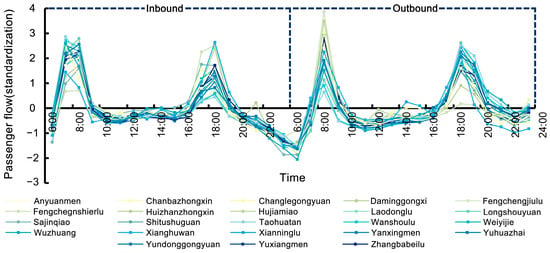
Figure 8.
Hourly distribution of passenger flow in and out of job–housing mismatch stations with high residential density.
- (3)
- Mismatch-biased employment stations with job–housing density balance
The time series distribution curve of the passenger flow for this particular type of station exhibits a bimodal variance, wherein the influx of passengers during the evening rush hour and the outflux of passengers during the morning rush hour surpass the influx of passengers during the morning rush hour and the outflux of passengers during the evening rush hour. Additionally, the peak hour coefficient of the station is of a greater magnitude. In comparison to stations characterized by the job–housing mismatch, this type of station displays commuting characteristics that are also mismatched, albeit to a lesser degree. The prominence of evening inbound peaks and morning outbound peaks further accentuates this difference, thus categorizing it as a mismatch-biased employment station. The land use composition in the station vicinity is marginally lower than that of employment-led stations; however, the employed and resident populations maintain a state of equilibrium. Therefore, this type of station can be classified as a mismatch-biased employment station with a job–housing density balance (Figure 9). Typical examples of such stations include Chaoyangmen, Hepingmen, and Wenjinglu.
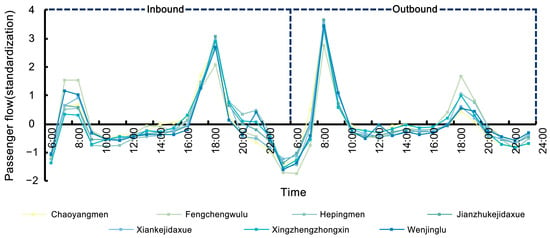
Figure 9.
Hourly distribution of passenger flow in and out of mismatch-biased employment stations with job–housing density balance.
- (4)
- Mismatch-biased employment station with high residential density
The time series distribution curve of passenger flow at this particular site exhibits a resemblance to that of mismatch-biased employment stations with a job–housing density balance, displaying a bimodal variance. However, the composition of the land surrounding this station is characterized by a low degree of heterogeneity, while the resident population significantly surpasses the employed population. Therefore, this station falls under the category of mismatch-biased employment stations with a high residential density (Figure 10), with typical examples including Jixiangcun and Taibainanlu.
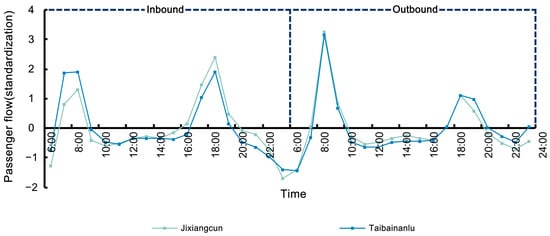
Figure 10.
Hourly distribution of passenger flow in and out of mismatch-biased employment stations with high residential density.
- (5)
- Mismatch-biased residence stations with high residential density
The time series distribution curve of the passenger flow for this type of station demonstrates a bimodal variance. In contrast to the peak locations observed at mismatch-biased employment stations, the influx of passengers during the morning rush hour and the outflow of passengers during the evening rush hour at mismatch-biased residence stations significantly exceed the influx of passengers during the evening rush hour and the outflow of passengers during the morning rush hour. The surrounding land composition of this station is characterized by a low degree of heterogeneity, while the resident population significantly surpasses the employed population. Therefore, this station falls under the category of mismatch-biased residence stations with a high residential density (Figure 11), with typical examples including Baihuacun, Beichitou, and Beiyuan.
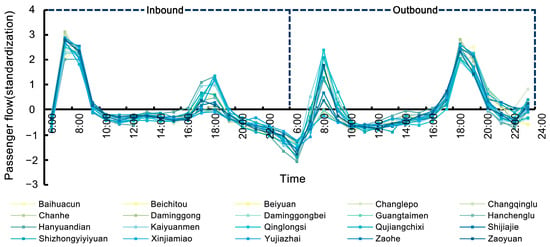
Figure 11.
Hourly distribution of passenger flow in and out of mismatch-biased residence stations with high residential density.
- (6)
- Comprehensive stations with job–housing density balance
The time series distribution curve of the passenger flow for this particular type of station exhibits a full-peak pattern. In contrast to the other station types, this specific category does not demonstrate a significant proportion of passenger flow during the morning and evening rush hours. Moreover, it possesses the smallest peak hour factor during these periods. However, after 2:00 p.m., the station experiences multiple peaks, indicating the complex nature of passenger travel purposes at this comprehensive station. The surrounding land area of this station exhibits a well-blended composition, characterized by a harmonious equilibrium between the employed and resident populations. Therefore, this type of station falls under the category of comprehensive stations with a job–housing density balance (Figure 12). Typical examples of such stations include Xiaozhai, Dayanta, and Zhonglou.
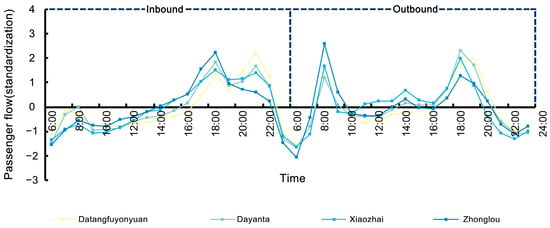
Figure 12.
Hourly distribution of passenger flow in and out of comprehensive stations with job–housing density balance.
To assess the significance of each variable in the cluster analysis, a one-way ANOVA was conducted on all variables, following the categorization of the stations. The magnitude of the effects of each variable was then determined based on the F-value (Table 6). The results reveal that the inbound skewness, outbound kurtosis, inbound peak hour coefficient, employed population density surrounding the station, and resident population density surrounding the station exert significant influences on the clustering results.

Table 6.
Variable ANOVA results.
4. Discussion
4.1. Spatial Distribution of Stations
The spatial distribution of various types of metro stations in Xi’an is depicted in Figure 13. Based on the spatial distribution characteristics of the stations, it is evident that the types of metro stations exhibit a circular expansion, with an evident aggregation effect for each type. However, the degree of intermingling among the various types of metro stations is not significant, thus failing to establish a clustered, complementary, and short-distance “mismatched” job–housing commuting circle.
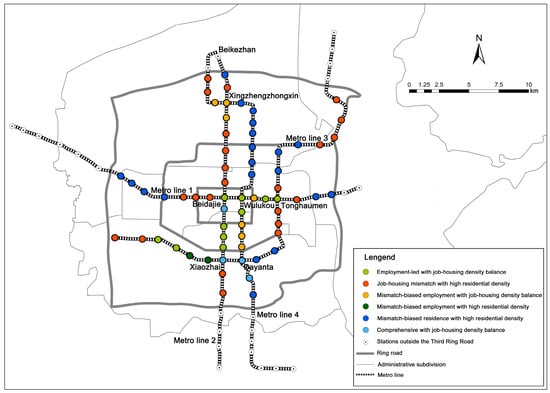
Figure 13.
Spatial distribution of stations based on type.
4.2. Spatial Rebalancing of Metro Stations
From a macroscopic perspective regarding the distribution of station types and employment spaces (Figure 14), it is evident that the metro stations along lines 1–4 in Xi’an’s third ring road exhibit a diverse range of types. This effectively facilitates the adaptive development of employment spaces along the rail transit line. However, upon conducting an analysis using standard deviation ellipses (Spatial Statistics), it becomes apparent that Xi’an’s urban rail transit stations possess distinct characteristics of circular–linear and clustered distribution patterns. In addition, the spatial distribution of the stations, when categorized by type, lacks equilibrium (Figure 15). Specifically, there is an excessive concentration of residential and employment stations, thereby giving rise to the phenomena of extensive spatial interactions and long-distance mismatched commuting in the city. In light of these findings, recommendations can be proposed to address the spatial rebalancing of metro stations in the study area, particularly through the reallocation of public resources.
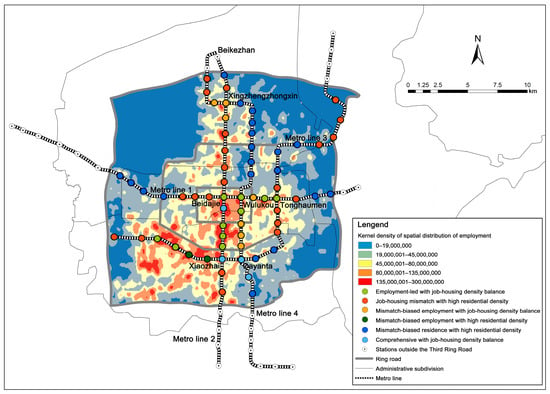
Figure 14.
Map of the spatial distribution of employment matched to each type of station.
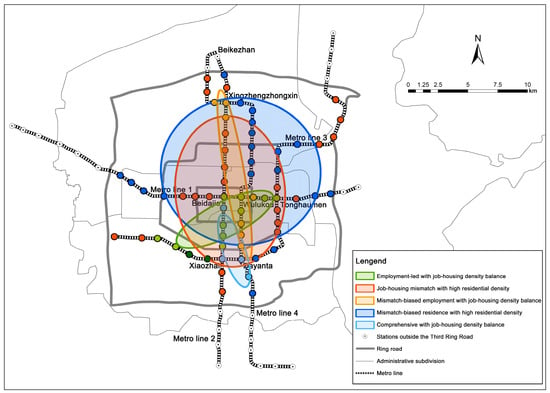
Figure 15.
Spatial statistics of stations based on type.
Land serves as the material and spatial medium for all productive and residential activities. The reasonable regulation of the proportion of industrial land to residential land holds the potential to effectively foster the integration of production and urbanization, as well as the attainment of job–housing equilibrium [44]. On the one hand, from the classification results, especially the “employment-led with job-housing density balance type”, the “mismatch-biased employment with job-housing density balance type”, and the “mismatch-biased employment with high residential density type”, it is revealed that the stations exhibit an employment-centric nature despite the presence of a balanced or even higher residential population density. This observation highlights the inadequacy of solely considering the congruence between the number of residents and the number of jobs at a station in achieving the objective of a “job-housing balance”. On the other hand, from the perspective of the spatial analysis of the stations, the spatial distribution of the stations based on the type division is unbalanced, reflecting the long-distance commuting problem based on urban rail transit. For this reason, it is necessary to further contemplate the actual requirements of the populace, including the complementarity of workers possessing diverse skill sets. Therefore, during the process of constructing or renovating land surrounding urban rail transit stations, due consideration must be given to the needs of the residents residing in the vicinity of these stations, thereby enhancing the overall “quality” of the land including these stations. To optimize the “quality” and “quantity” of land surrounding transportation hubs, two approaches can be undertaken. Firstly, it is necessary to rectify the incongruity between the demographic composition residing in the vicinity of these hubs and the income generated from employment opportunities. Secondly, the planning and design of the peripheral areas surrounding urban rail transit stations should not be driven solely by the pursuit of land integration in the station area. Attention must be paid not only to the occupancy-to-residence ratio but also to the calibration of land design, ensuring that job wages cater to the diverse socioeconomic strata. In order to enhance the independence index [45], an evaluation system can be established, including the assessment criteria of “job income + number of jobs” versus the “number of residences + cost of residence”.
The essence of the job–housing mismatch is derived from a complex relationship among housing costs, commuting expenses, and personal income. The dislocation of employment and housing space caused by the adjustment of urban spatial structures restricts middle and low incomes, rendering them the primary demographic grappling with the conundrum of “job-housing imbalance” through job search and residential re-locations. The spatial distribution analysis of metro stations reveals that the residential stations with a bias towards mismatched commuting are evenly dispersed along the periphery of the third ring in contrast to the other station types. This indicates a scarcity of employment opportunities and a pronounced concentration of residential areas in the outskirts of Xi’an. Conversely, the central city and Gaoxin zones, benefiting from administrative resources, exhibit an evident concentration of employment dynamics. To solve this problem, it is suggested to appropriately disperse the middle- and high-end income industries in the core area and set up appropriate middle- and high-income positions in the core area of the cluster network of urban rail transit stations, enhance the radiation and aggregation ability of the peripheral core TOD, explore the complementary and spatial aggregation relationships of workers with different skills, and gradually form a balanced development space similar to Gaoxin zones. Furthermore, the government must offer residents with a wider array of housing options and public services, actively promoting the implementation of guaranteed rental housing, optimizing the supply structure, and striving to meet the employed population’s needs. Simultaneously, the government should incentivize employers to provide rental housing or dormitories for new employees, accompanied by appropriate policy support. Accommodations offered by employers, in close proximity to the workplace, objectively ameliorate the issue of mismatched commuting.
4.3. Limitations
Future studies should address the limitations of this study. Firstly, this study utilized mobile phone signaling data from 2019, during which time the study area consisted of only 66 metro stations. These stations were classified into six categories. However, it is important to note that urban rail transit has experienced significant growth in recent years, resulting in an increased number of stations. Therefore, the current classification results do not comprise all of the stations in this study area. Subsequent classification studies should focus on the urban rail transit stations in the study area to compare the spatio-temporal evolution characteristics of different station types. Secondly, due to limited resources, the study lacked detailed built environment elements such as site POI. Future studies should aim to collect these data to enhance and refine the measurements of built environment characteristics around stations. This will provide a more comprehensive understanding of the correlation between the built environment and passenger flows at different types of stations. Finally, it is important to note that the absence of weekend data pertaining to inbound and outbound passenger flows at urban rail transit stations hinders the analysis of evolving patterns in weekend metro station ridership. Notably, urban rail transit stations exhibiting high ridership during weekends are typically situated in densely populated urban areas that feature a plethora of commercial and recreational establishments, thereby attracting a significant number of residents. Therefore, the inclusion of weekend inbound and outbound passenger flow data from urban rail transit stations in future studies will contribute to a more comprehensive categorization of station types.
5. Conclusions
Urban rail transit stations serve as pivotal nodes in urban public transportation systems, exhibiting differences in terms of the land composition, passenger commuting patterns, and crowd attributes across various station types. The classification of urban rail transit stations facilitates a profound understanding of the interdependent relationship between the spatial attributes of station vicinities and passenger flow, thereby offering invaluable support for urban transportation development and planning. In this study, a novel approach is proposed to classify urban rail transit stations predicated upon the vantage point of “passenger flow behavior, land use structure, and job-housing density”.
In a groundbreaking manner, this study harnesses mobile phone signaling data to extract both inbound and outbound passenger flow for each hour spanning from 6:00 to 24:00 in a single day. Subsequently, the 66 stations situated in Xi’an are categorized into six distinct archetypes, namely employment-led stations with a job–housing density balance, job–housing mismatch stations with a high residential density, mismatch-biased employment stations with a job–housing density balance, mismatch-biased employment stations with a high residential density, mismatch-biased residence stations with a high residential density, and comprehensive stations with a job–housing density balance. Among the 15 characteristics employed for station classification, variables including the resident count, employment count, inbound skewness, outbound kurtosis, and inbound peak hour coefficient effectively reflect the attributes of urban rail transit stations. Conversely, variables such as the outbound maxima, site dominance, and site uniformity index do not exert significant influences on station classification. In this light, compared with the research of Duan [10] and Cui [22], we emphasize that the relevant indicators of the surrounding built environment should not only select the characteristics of land use structure to analyze different types of urban rail transit stations in a station classification study, but should also use more granular data around the stations, such as POI, occupational and residential populations, road network density, intersection density, etc., thus providing the basis for a fine division of site types.
The spatial distribution of each type of metro station in Xi’an aligns with the city’s spatial development pattern, as revealed by our analysis. However, the urban rail transit stations in Xi’an do not form clusters that foster complementary development, thereby reflecting the prevailing trend of inter-regional commuting flow in the city. Therefore, it is necessary to consider a further optimization of the job and residence structures surrounding stations with job-residence mismatches. Our study findings highlight that achieving the objective of a “job-housing balance” necessitates more than merely matching the number of residents and jobs around stations. Instead, it requires a deeper understanding of the actual needs of the population, including the complementarity of workers with diverse skill sets and the spatial agglomeration bias. Based on different types of metro stations, the sustainable and coordinated development of public transport and land use can be achieved through rational land use planning, the rational allocation of urban infrastructure and public service facilities, and the improvement of metro operation efficiency.
Author Contributions
Conceptualization, H.F. and Y.C.; methodology, H.F., Y.C. and Y.W.; software, Y.C., Z.Z. and J.W.; validation, Y.C., J.W. and Z.W.; formal analysis, H.F. and Y.C.; investigation, Y.C. and J.W.; resources, H.F. and Y.W.; data curation, Y.C., J.W. and Z.Z.; writing—original draft preparation, Y.C. and H.F.; writing—review and editing, Y.C., H.F. and Y.W.; visualization, Y.C. and J.W.; supervision, H.F. and Y.C.; project administration, H.F. and Y.C.; funding acquisition, H.F. All authors have read and agreed to the published version of the manuscript.
Funding
This research was funded by the Fundamental Research Funds for the Central Universities, CHD (grant number: 300102341503), and the Opening Fund of the State Key Laboratory of Green Building (grant number: LSZZ202014).
Institutional Review Board Statement
Not applicable.
Informed Consent Statement
Not applicable.
Data Availability Statement
The data cannot be made available due to confidentiality reasons.
Acknowledgments
The authors sincerely thank the editors and anonymous reviewers for their kind views and constructive suggestions.
Conflicts of Interest
The authors declare no conflict of interest.
Appendix A
Mobile phone signaling data are generated through various user activities, such as making phone calls, sending text messages, and changing locations. These events are captured and recorded via the communication base stations operated by the service provider. The mobile phone signaling data comprise a wide range of information, including a user’s travel trajectory, spatial location, type of stay at a particular location, latitude and longitude coordinates of the location point, start and end times of the stay, and the mode of transportation used. Notably, a stay is defined as a user remaining at the same location for a duration exceeding 30 min, and each stay behavior is recorded.
In the city of Xi’an, the distance between Unicom mobile signaling base stations ranges from 250 to 400 m. The work and residential locations of approximately 1.3907 million users in Xi’an were identified. When compared with the 7.6128 million urban residents documented in the 2019 Statistical Bulletin of Xi’an’s National Economic and Social Development, the identification rate reached 20%. By comparing the population ratios from different districts in the central urban area of Xi’an with the ratios derived from mobile phone signaling, it can be concluded that the comparison results exhibit linear and positive correlations, indicating that the data have a strong correlation.
References
- Han, B.M.; Li, Y.W.; Lu, F.; Yang, Z.X.; Yang, R.X.; Chen, Y.X.; Sun, Y.J.; Xi, Z.; Wang, L.Y.; Dai, Y.J. Statistical analysis of urban rail transit operations in the world in 2021: A review. Urban Rapid Rail Transit 2022, 35, 5–11. [Google Scholar] [CrossRef]
- Yang, X.X.; Zou, Y.J.; Chen, L. Operation analysis of freeway mixed traffic flow based on catch-up coordination platoon. Accid. Anal. Prev. 2022, 175, 106780. [Google Scholar] [CrossRef]
- Jiang, Y.S.; Yi, Z.Y.; Xiao, G.S.; Li, H.W.; Yao, Z.H. Modeling the Effect of the Platoon Size of CAVs on Mixed Traffic Flow: A Cellular Automaton Method. J. Adv. Transp. 2023, 2023, 2761858. [Google Scholar] [CrossRef]
- Jin, Y. The Influence of Land Use on Diurnal Pattern of Urban Mass Transit Station Boardings: A Case Study of Shanghai City. Mod. Urban Res. 2015, 6, 13–19. [Google Scholar] [CrossRef]
- Pan, H.X.; Wei, C.D.; Shi, C. Difference Analysis of Rail Traffic Accessibility Effect Housing Price: Shanghai Center City Example. Planners 2016, 32, 203–208. [Google Scholar] [CrossRef]
- Zhang, Y.; Ku, Z.W.; Zhou, W. Study on the Spatial Matching of Occupation and Residence in Large Cities and its Co-ordinated Development with Railway Transportation: A Case Study of Shenzhen Municipality. Urban Plan. Forum 2018, 1, 99–106. [Google Scholar] [CrossRef]
- Wang, Z.J.; Liu, H.X.; Tanku, F. Classification of service functions in urban railway stations based on AFC data and RF models. J. Transp. Syst. Eng. Inf. Technol. 2018, 18, 224–230. [Google Scholar] [CrossRef]
- Pang, L.; Jiang, Y.; Wang, J.; Qiu, N.; Xu, X.; Ren, L.; Han, X. Research of Metro Stations with Varying Patterns of Ridership and Their Relationship with Built Environment, on the Example of Tianjin, China. Sustainability 2023, 15, 9533. [Google Scholar] [CrossRef]
- Yu, Z.; Zhu, X.; Liu, X. Characterizing metro stations via urban function: Thematic evidence from transit-oriented development (TOD) in Hong Kong. J. Transp. Geogr. 2022, 99, 103299. [Google Scholar] [CrossRef]
- Duan, D.G.; Zhang, F. Study on Classification of urban rail transit stations from the perspective of landuse optimization:A case study on Xi’an subway line 2. City Plan. Rev. 2013, 37, 39–45. [Google Scholar]
- Yu, L.J.; Li, Y.; Chen, K.M. Using Spectral Clustering for Urban Rail Station Classification. J. Transp. Inf. Saf. 2014, 32, 122–125. [Google Scholar] [CrossRef]
- Wang, W.Y.; Liu, J.C.; Yu, Y.D. Research on classification of rail transit stations in Xi’an based on land use and population. People’s Public Transp. 2020, 8, 29–33. [Google Scholar] [CrossRef]
- Xia, X.; Gai, J.Y. Classification of urban rail transit stations and points and analysis of passenger flow characteristics based on K-Means clustering algorithm. Mod. Urban Transit 2021, 4, 112–118. [Google Scholar]
- Jiang, Y.; Zheng, H.; Yu, S.Y.; Tang, X. Relationship Between Job-Housing Spatial Distribution and Rail Transit Network in Tianjin: An Analysis Based on Cellular Data. Urban Transp. China 2018, 16, 26–35. [Google Scholar]
- Ren, L.J.; Yun, Y.X.; Quan, H.Y. Study on Classification and Characteristics of Urban Rail Transit Station Based on Node-Place Model Empirical Analysis and Experience Enlightenment of Singapore. Urban Plan. Int. 2016, 1, 109–116. [Google Scholar]
- Bertolini, L. Nodes and places: Complexities of railway station redevelopment. Eur. Plan. Stud. 1996, 4, 331–345. [Google Scholar] [CrossRef]
- Bertolini, L. Spatial Development Patterns and Public Transport: The Application of an Analytical Model in the Netherlands. Plan. Pract. Res. 1999, 14, 199–210. [Google Scholar] [CrossRef]
- Chen, Z.; Batty, M.; Manley, E.; Wang, J.; Wang, Z.; Feng, C.; Schmitt, G. Variability in regularity: Mining temporal mobility patterns in London, Singapore, and Beijing using smart-card data. PLoS ONE 2016, 11, 0149222. [Google Scholar] [CrossRef]
- Yin, Q.; Meng, B.; Zhang, L.Y. Classification of subway stations in Beijing based on passenger flow characteristics. Prog. Geogr. 2016, 35, 126–134. [Google Scholar]
- Tan, Z.Z.; Li, S.Y.; Li, X.; Liu, X.P.; Chen, Y.M. Clustering of Metro Stations in Guangzhou based on Passenger Flow. Trop. Geogr. 2017, 37, 102–111. [Google Scholar]
- Yuan, F.T.; Cheng, T.J.; Wei, J.B. Research on Classification of Rail Stations Based on AFC Data. J. Transp. Eng. 2021, 21, 48–52. [Google Scholar] [CrossRef]
- Cui, X.; Yu, B.J.; Liang, P.P.; Wang, L.; Zang, L.F. Urban rail transit station type identification and job housing spatial rebalancing based on passenger flow and land use: Taking Chengdu as an example. Mod. Urban Res. 2021, 7, 68–79. [Google Scholar]
- Meekyung, M. Classification of Seoul metro stations based on boarding/Alighting patterns using machine learning cluster-ing. J. Inst. Internet Broadcast. Commun. 2018, 18, 13–18. [Google Scholar] [CrossRef]
- Ma, X.; Wu, Y.J.; Wang, Y.; Feng, C.; Liu, J. Mining smart card data for transit riders’ travel patterns. Transp. Res. Part C Emerg. Technol. 2013, 36, 1–12. [Google Scholar] [CrossRef]
- Zhou, Y.; Fang, Z.X.; Zhan, Q.M.; Huang, Y.P.; Fu, X.W. Inferring social functions available in the metro station area from passengers’ staying activities in smart card data. ISPRS Int. J. Geo.-Inf. 2017, 6, 394–397. [Google Scholar] [CrossRef]
- Chen, Y.; Yao, M.; Cai, Z. Research on the classification of urban rail transit stations-taking Shanghai metro as an example. In Proceedings of the 15th International conference on service systems and service management (ICSSSM), Hangzhou, China, 21–22 July 2018; pp. 1–6. [Google Scholar]
- Roth, C.; Kang, S.M.; Batty, M.; Barthelemy, M. Structure of urban movements: Polycentric activity and entangled hierarchical flows. PLoS ONE 2011, 6, 15923. [Google Scholar] [CrossRef]
- Wang, Y.L.; Jin, Y.N.; Wu, B. Definition and Classification Method of Rail Transit Stations Under TOD. Traffic Transp. 2021, 37, 51–56. [Google Scholar]
- Liao, C.; Scheuer, B. Evaluating the performance of transit-oriented development in Beijing metro station areas: Integrating morphology and demand into the nodeplace model. J. Transp. Geogr. 2022, 100, 103333. [Google Scholar] [CrossRef]
- Jiang, Y.S.; Yu, G.S.; Hu, L.; Li, Y. Refined Classification of Urban Rail Transit Stations Based on Clustered Station’s Passenger Traffic Flow Features. J. Transp. Syst. Eng. Inf. Technol. 2022, 22, 106–112. [Google Scholar] [CrossRef]
- Zhou, Y.; Zheng, S.; Hu, Z.; Chen, Y. Metro station risk classification based on smart card data: A case study in Beijing. Phys. A Stat. Mech. Its Appl. 2022, 594, 127019. [Google Scholar] [CrossRef]
- Xi’an National Economic and Social Development Statistics Bulletin 2022. Available online: http://tjj.xa.gov.cn/ (accessed on 23 September 2023).
- Xi’an Metro Mileage Exceeds 300 Kilometres. Available online: https://news.cctv.com/ (accessed on 23 September 2023).
- Overview of China’s Metro. Available online: https://metrodb.org/ (accessed on 23 September 2023).
- Xi’an Municipal People’s Government. Available online: https://www.xa.gov.cn/ (accessed on 30 September 2023).
- Feng, H.X.; Yang, H.; Yv, Y.; Wang, Y.Z.; Qin, P.C.; Zhao, Z.Q.; Jing, Q.H. A travel mode identification method based on mobile phone signaling data: China. CN202011366779.0, 16 August 2022. [Google Scholar]
- Lv, D.J.; Li, S.Y.; Tan, Z.Z.; Wu, Z.F.; Gao, F.; Liu, X.P. Fine-Scale Modeling of Multi-time Dimensional lnfluencing Factors in Transit Ridership at MetroStations: A Case Study of Guangzhou City. Geogr. Geo-Inf. Sci. 2019, 3, 58–65. [Google Scholar] [CrossRef]
- Long, Y.; Zhang, Y.; Cui, C.Y. Identifying Commuting Pattern of Beijing Using Bus Smart Card Data. Acta Geogr. Sin. 2012, 67, 1339–1352. [Google Scholar] [CrossRef]
- Xie, H.; Zhang, L.; Lim, C.P.; Yu, Y.; Walters, J. Improving K-means clustering with enhanced Firefly Algorithms. Appl. Soft Comput. 2019, 84, 105763. [Google Scholar] [CrossRef]
- Omrani, H.; Parmentier, B.; Helbich, M.; Pijanowski, B. The land transformation model-cluster framework: Applying k-means and the Spark computing environment for large scale land chan ge analytics. Environ. Model. Softw. 2019, 111, 182–191. [Google Scholar] [CrossRef]
- Li, S.Y.; Lv, D.J.; Huang, G.P.; Zhang, X.H.; Gao, F.; Chen, Y.T.; Liu, X.P. Spatially varying impacts of built environment factors on rail transit ridership at station level: A case study in Guangzhou, China. J. Transp. Geogr. 2020, 82, 102631. [Google Scholar] [CrossRef]
- An, D.; Tong, X.; Liu, K.; Chan, E.H.W. Understanding the impact of built environment on metro ridership using open source in Shanghai. Cities 2019, 93, 177–187. [Google Scholar] [CrossRef]
- Huang, J.; Wang, J.E.; Jin, H.T.; Jin, F.J. Investigating spatiotemporal patterns of passenger flows in the Beijing metro system from smart card data. Prog. Geogr. 2018, 37, 397–406. [Google Scholar] [CrossRef]
- Gao, L.; Xu, Y.K. Study on the Ratio of Industrial Land to Residential Land in Guangzhou under the Perspective of Occupational and Residential Balance. Planners 2018, 34, 77–82. [Google Scholar]
- Niu, X.Y.; Ding, L.; Song, X.D. Analyzing suburban new town development on SHANGHAI from the perspective of Jobs-Housing spatial relationship. City Plan. Rev. 2017, 41, 47–53. [Google Scholar]
Disclaimer/Publisher’s Note: The statements, opinions and data contained in all publications are solely those of the individual author(s) and contributor(s) and not of MDPI and/or the editor(s). MDPI and/or the editor(s) disclaim responsibility for any injury to people or property resulting from any ideas, methods, instructions or products referred to in the content. |
© 2023 by the authors. Licensee MDPI, Basel, Switzerland. This article is an open access article distributed under the terms and conditions of the Creative Commons Attribution (CC BY) license (https://creativecommons.org/licenses/by/4.0/).












